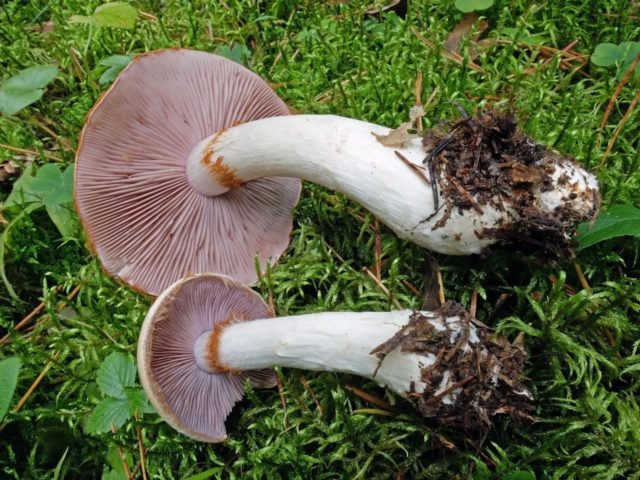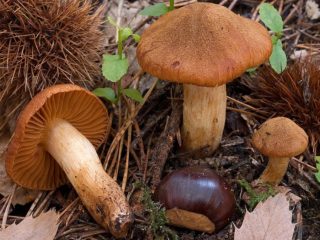Content
The variable cobweb is a member of the Cobweb family, the Latin name is Cortinarius varius. Also known as multicolored webweed or brick-brown sticky web.
What does the web spider look like?

Along the edge of the cap you can see the remains of a brown blanket
The fruiting body of this species consists of a fleshy cap and a rather thick stalk. The spore powder is colored yellow-brown. The pulp is whitish, dense, elastic, with a subtle musty odor.
Description of the cap

Has many poisonous and inedible counterparts
In young specimens, the cap is hemispherical in shape with the edges turned inward; as they grow older, it becomes convex. The diameter varies from 4 to 8 cm, but there are specimens in which the cap reaches 12 cm. Adult mushrooms are distinguished by drooping or curved edges. The surface is slimy, orange-brown with lighter edges and a dark red center. On the underside of the cap there are frequent plates, the color of which at the initial stage of ripening is purple, becoming pale brown over time. Young specimens have a clearly visible white cover.
Description of the leg

Can grow either singly or in small groups
The leg of the spider web is characterized as club-shaped, its length varies from 4 to 10 cm, and its thickness varies from 1 to 3 cm in diameter. Some specimens may have a thick tuber at the base. The surface is smooth, dry, silky to the touch. Initially white, gradually becomes yellowish. Almost at the base of the leg there is a ring of light brown color.
Where and how does it grow
This species prefers coniferous and deciduous forests, most often found in the southern and eastern regions. The optimal time for fruiting is from July to October.
Is the mushroom edible or not?
The variable cobweb belongs to the group of conditionally edible mushrooms. In Europe, this species is considered edible and is quite popular. Suitable for preparing second courses, marinating and salting.
Doubles and their differences

The pulp is white, slightly bitter
In terms of external features, the variable web spider is similar to some of its relatives:
- Common spiderwort - inedible species. Initially, the doppelganger's cap is hemispherical with a curved edge, but gradually becomes prostrate. Its color varies from pale yellow or ocher to honey brown, with the middle always darker than the edges. A special feature is the pedunculated band, which consists of concentric fibers of brown or yellow-brown color.
- Straight cobweb - belongs to the group of edible mushrooms. You can distinguish a double by its straight bluish or lavender leg. It is not found often and is located in deciduous or mixed forests where aspen trees grow.
Conclusion
Variable cobweb can be found in deciduous and coniferous forests. In some foreign countries, dishes made from this specimen are considered a delicacy, and in Russia it is classified as a conditionally edible mushroom. You can eat it, but only after pre-treatment. In addition, it is important to verify the authenticity of the species, since the variable web spider has many inedible and even poisonous counterparts, the use of which as food can lead to serious poisoning.










